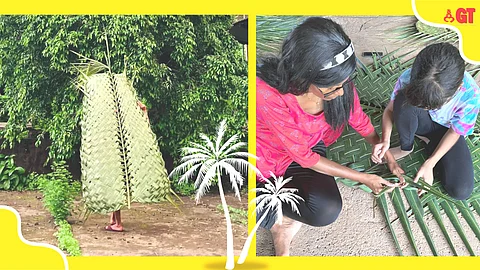

By Casey Monteiro
Back in the day, coconut palm mat weaves adorned balcaos (balconies) and porches of Goan houses, giving a rustic, cool and breezy ambience. This was gradually replaced by the jarring plastic sheets in bright hues, which were easily available, convenient and durable.
What was lost was an eco-friendly covering that protected the house in varied weather conditions. In a bid to revive this traditional mat-weaving, called mollam in Konkani, Sabina Da Cunha from Parra, has been conducting workshops and teaching others this skill of making mollam.
Sabina learnt this craft at an early age. She recalls, “I was about six-years-old. I remember my parents and grandma used to weave these palm mats as a cover for our house to keep us safe from the rains. My grandma encouraged me to learn it.”
These palm mats were used not only in houses as a protective covering from the rain, but were also used to cover sheds which were used to stock firewood. And, with a little twist, were also used as a ‘raincoat’ in fields!
These mats, when folded in half and tied, became baskets to store things such as coconut shells.
Today, you will see these woven palm leaves are generally used to construct temporary beach shacks. These are also seen in many resorts and gives these tourist structures an ethnic view and feel, says Sabina.
CHALLENGES TO WEAVING
This craft has its fair share of challenges, too. Difficulty sourcing palm leaves, and most importantly, finding coconut pluckers and people who weave these leaves compounds the problem of finding and utilising these mats.
Says Sabina, “Lifestyles have changed. There’s more of buildings and constructions, and less of nature. Coconut trees are being cut.”
“In villagers, people still use palm mats. But, since they cannot be sourced easily, they are priced slightly higher as its also akin to working out at the gym when it comes to weaving them!” says Sabina, talking of the hurdles faced.
WEAVING WORKSHOPS
Sabina feels the use of these coconut palm mats can be extended to being used as eco-friendly mats in gardens and parks.
“This technique can be used to make hats and baskets, and I look forward to diversifying in this art, too, in due course of time,” she informs.
So far, she has been getting a good response for the workshops she conducts. “The response has been amazing,” she says, adding how it’s mostly non-Goans who are showing a keen interest in this art.
“I have received a lot of enquiries from schools and colleges, as well as resorts to conduct such workshops for them. It gives me immense happiness to be a part of this art revival and share it with this generation,” she says.
Tanya Carvalho Fernandes, proprietor of Edricia Farm, Siolim, which hosts the mollam-making workshops regularly, says that such workshops educate the present generation about the work done by our ancestors.
She expresses how amazing it would be to see such mats, woven from palms, utilised in today’s times, instead of the plastic covers and sheets which have taken over, even though plastic is expensive. Appealing to people to support traditional artistes, she says that the world we live in would become a much better place if we did so.
Mollam-making workshops are held every Saturday at Edricia Farm, Siolim, from 4 pm to 5 pm. The fee is ₹ 300 per participant.
Schools, colleges or organisations interested in hosting mollam-making workshops may contact Sabina Da Cunha on +91 9923 826 412.